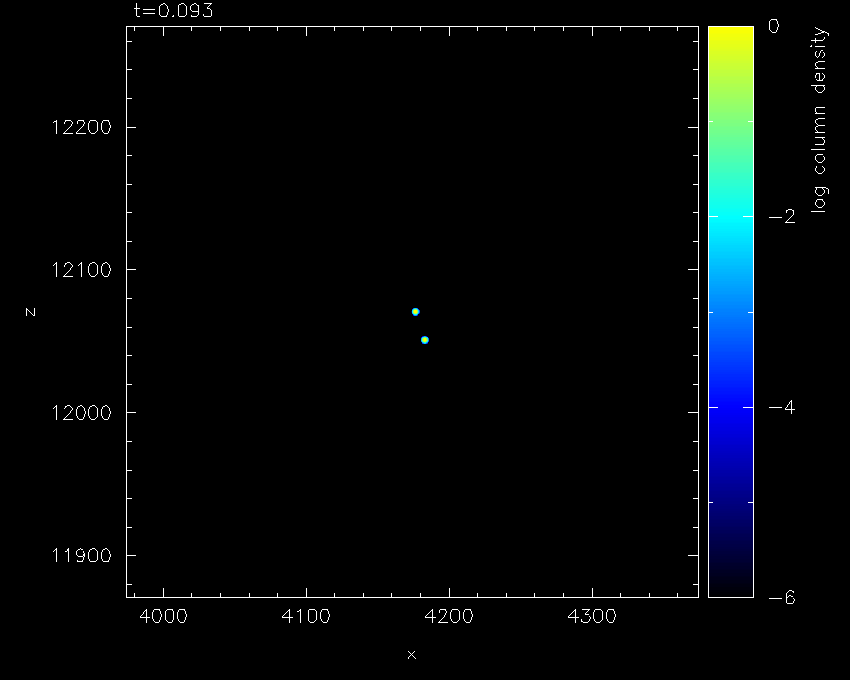The email from Evert Glebbeek, a postdoc in the department working with Alison Sills, popped into my inbox and nearly made me pop out my chair. What did he mean this researcher worked on stellar collisions? Stars didn't collide! All the models I had made governing their motions through my simulated galaxy assumed this was the case. If it turned out not to be ... if it turned out stars did regularly slam into each other ... if it turned out that ALL MY RESEARCH WAS WRONG ...!
The email continued by saying that they were going for dinner at a local Indian restaurant that evening. I cast aside my keyboard and told Evert I would be taking the chicken vindaloo.
In fact, I need not have been so worried. The ratio between the size of a star compared to the distance between them is normally so large that even when galaxies merge, the stars do not run into one another. The chance of a star like our Sun hitting another star is so remote that we would have to wait for the entire age of the Universe for it to occur.
There are, however, other places in our galaxy where the probability of two stars colliding is much higher. The first is in dense clusters of stars and the second is in the centre of our galaxy, close to the super-massive black hole. Over dinner, Fabio explained to me that it was the latter scenario that he was investigating; looking at a population of stars close enough to the central black hole that they could be strongly affected by the force of its gravity.
Despite the frightening images that a black hole conjures up, if you remain outside its event horizon there is no particular cause for alarm. Objects that drift past this point can never be seen again, but stars at a greater distance can orbit the super-massive black hole safely in the same way as the Earth goes around the Sun. Yet Fabio told me there is something very strange about a few of the stars very close to our galaxy's super-massive black hole; namely, that they are very young.
Stars form when clouds of gas become dense enough that they collapse under their own gravity. Once this has happened, the object produced is very hard to break apart, but during its formation the cloud can be more easily disrupted by an outside influence. Close to the super-massive black hole, clouds are not able to form stars before the black hole's gravity rips them to pieces. Stars that are found in this region are therefore usually older objects that were born further out in the galaxy and have been scattered in over time. How there could be young stars so close to the black hole was consequently a mystery, but one Fabio thinks he has found a solution to during his PhD work.
Fabio postulates that a known mechanism for breaking apart binary stars might sometimes go the opposite way, and cause two stars to merge. In a binary system, two stars are born so close together that they orbit about a common point between their centres. When such a pair approach the super-massive black hole, the black hole's gravity can disrupt the binary, resulting in one star orbiting the black hole and the other being ejected out of the galaxy at high velocity. In Fabio's models, a similar event occurs but instead a star being ejected, the black hole's influence makes the binary stars collide and merge to form a single object. This new composite star has the same chemical composition as the two old stars, but is now twice the mass. This makes it appear to observers to be much younger than it truly is, since more massive stars evolve faster than their lighter counterparts.

This movie shows the results of one of Fabio's simulations[*] of a binary merging due to the gravitational influence of a super-massive black hole. The black hole is not shown directly, but its effects can be seen upsetting the orbit of the two stars which get steadily closer and collide, before settling into a single object. [Click on the movie to play and if that sadly fails click here. If you weren't concentrating and want to start the movie from the beginning but 'reload' is treating you badly, try hitting 'shift' at the same time as 'reload'.]
This was an exciting look at one of the most dangerous areas of the galaxy. Nevertheless, from the point of view of the fate of the Earth, I was rather glad we were hanging out in a quieter suburb.
--
[*] Journal reference: Antonini, Lombardi & Merritt, 2010, astro-ph/1008.5369 .

No comments:
Post a Comment